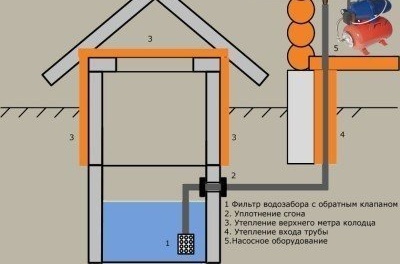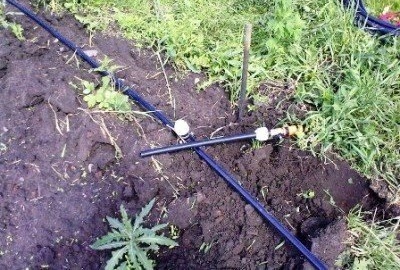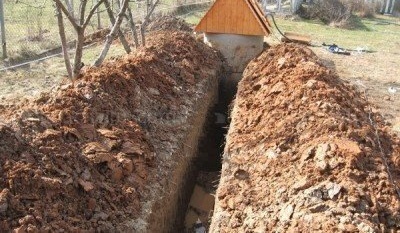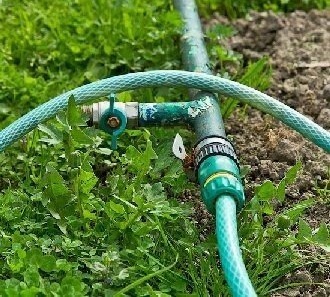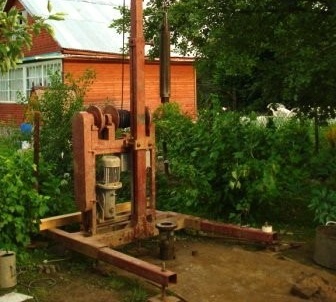Water supply in the country from the well: analysis of the components of the system
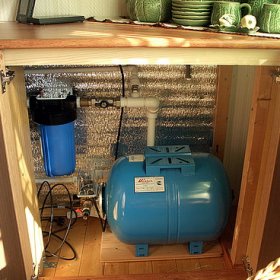
A modern person, accustomed to the benefits of civilization, can hardly endure their absence, so he seeks to provide his country house with water supply. However, this is not so easy to do in the absence of the necessary engineering communications. However, even in such conditions, water can be supplied in several ways, one of them is the water supply in the country from the well.
Content
Why exactly the well?
The basis of an autonomous water supply system may be a well or a well. Many prefer the second option. And this is easy to explain, because such a device has many advantages:
- Low cash costs for the arrangement.
- The construction will last much longer than any type of well.
- The aquifers of the well are less likely to silt. Even if this happens, you can clean them yourself using a shovel and bucket.
- Water pipes of this type are more convenient in operation and maintenance. The process of preserving the system is also much simpler.
Replacing the solenoid valve or pump can be done without dismantling the structure.
Main components and system design
Any water supply scheme from a well includes several basic elements:
Pump selection
The device can be either submersible or surface. Experts recommend choosing a submersible device. They have high performance, can work at great depths, are economical and low noise. The brand of the device and its power are selected depending on the depth at which it will work.
Accumulator
Equipment is necessary to protect the system from water hammer and stabilize the pressure in the water supply. A pressure storage tank with a membrane accumulates water, therefore, even in case of power outages, its supply will continue for some time.
The volume of the tank may be different. When choosing it, you need to take into account that the amount of water that will be in the tank is much less than the nominal volume of the device.
Drain valve
The design is installed at the lowest point of the system, that is, immediately after the pump. Used to drain water from the system during conservation. If the well has a depth of not more than 8 m and is located close to housing, you can install another device instead of a drain valve. A non-return valve is mounted in the house, and directly in front of it is a bypass system with a crane. As soon as the faucet opens, the vacuum created by the check valve disappears and all the water from the system drains.
Pressure switch
It is installed next to the accumulator to maintain optimal pressure values in the structure. The relay reduces or increases the pressure in the pipeline while the pump supplies water to the accumulator tank. As soon as the maximum pressure is reached, the device switches off the pump. When the value decreases to a minimum, the relay closes the contacts and water injection begins.
In addition to these devices, water pipes are needed. Professionals recommend the use of parts made of polypropylene, which are durable, reliable, environmentally friendly, easy installation and affordable price. You may also need a water heating cable, which will not allow the pipes to freeze in the cold season. If the amount of water in the well is small, it is recommended to install a dry running relay, which will protect the pump in the event of a sharp drop in water level.
Another nuance: the water supply from the well to the house is mandatory installed under a slope, which is directed towards the drain valve. Thus, it is possible to completely drain the water from the structure without problems. Inside the house, all the wiring is also equipped with a mandatory bias towards the supply pipe, which becomes a drain during the conservation of the system.
Winter and summer version of the water supply
The system, depending on the needs of the owners, can be mounted:
- In the summer version, when the device is supposed to function only in warm time.
- A winter building that can work year-round, even if they don’t live permanently in the cold in the country, but only come for a short time.
Both options are considered conditionally autonomous, since they depend on the availability of electricity.
Summer system
The device of the summer water supply from the well can be performed in two ways: collapsible or permanent. The second option is a conventional pipeline laid in the ground with water taps facing the surface. It is worth noting that the depth of the laying of pipes in this case is small, they are literally sprinkled with earth. The design is very convenient in that the points of tapping can be organized in any desired place.
A significant drawback of the system is the need to lay pipes with a slope to the line, to where the lowest point of the system with a tap for draining water is located. If this rule is neglected, water will remain in the pipes, which, when the temperature drops to negative values, will simply break them.
The collapsible design is extremely easy to install. It is installed in the warm season and is stored for storage before the onset of cold weather. The structure consists of pipes or hoses laid over the ground in the right direction. Parts should be strong enough and possibly reinforced. To make the construction as reliable as possible, connecting adapters made of plastic or galvanized steel are installed.
Winter building
Winter water supply from the well, which can also be equipped with your own hands, is carried out only according to a permanent scheme. For its functioning, it will be necessary to insulate the entire system, since it will work even at low temperatures. Begin with the connection of the pump to the voltage source. You can combine the cable and the water supply inside the common casing from a large diameter plastic sewer pipe, which will protect the parts from freezing and mechanical damage.
Water pipes in this case are laid below the level of soil freezing, which guarantees their safety and performance. However, for various reasons this is not always feasible. In this case, one can proceed as follows.We dig a trench 60 cm deep, lay the pipes and fill them with insulation with a layer of 30 cm. For these purposes, slag, polystyrene foam or expanded clay is suitable. We lay the soil on top. Also, a water heating cable can be installed on the pipeline, an effective, but quite expensive device to operate.
To connect the pump to the pipeline, we equip the so-called pit. Its dimensions are on average 75x75 cm, depth - 1 meter. The walls of the structure are strengthened with brick or boards, the bottom is rammed, covered with rubble or poured with concrete. The pipeline is led inside the structure, where it is connected to the pump. To protect against freezing, the sump is well insulated.
It should be emphasized that the winter version of the system is necessarily equipped with a conservation system. In the cold season, before each departure of residents from the dacha, water is drained from the pipeline, which allows you to keep the structure in good condition. Upon arrival, the system will be easy to start again.
Autonomous water supply allows providing a country house with water even in the absence of centralized communications. Water piping from a well is practical, effective and relatively cheap. It doesn’t matter if the summer or winter version of the system is installed, with proper construction of the structure, the summer cottage will be provided with uninterrupted water supply.
